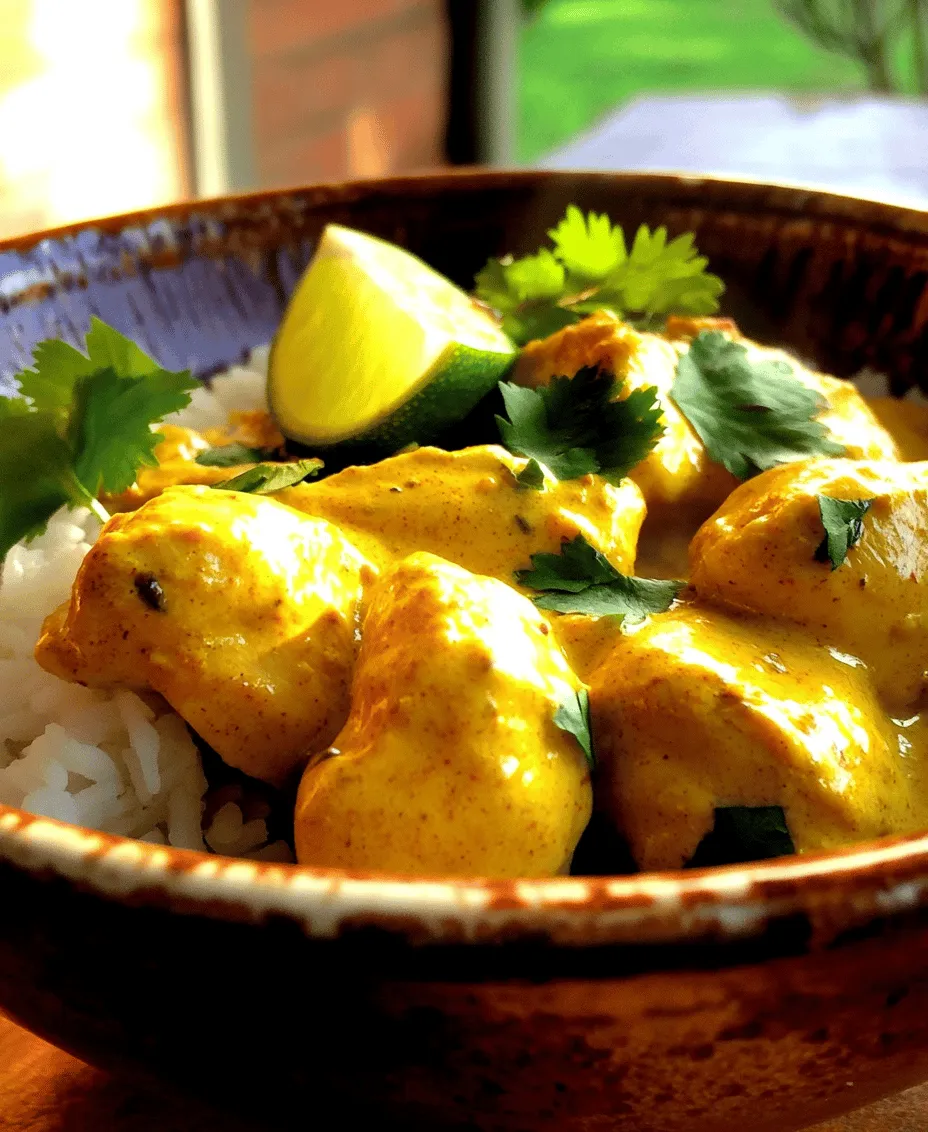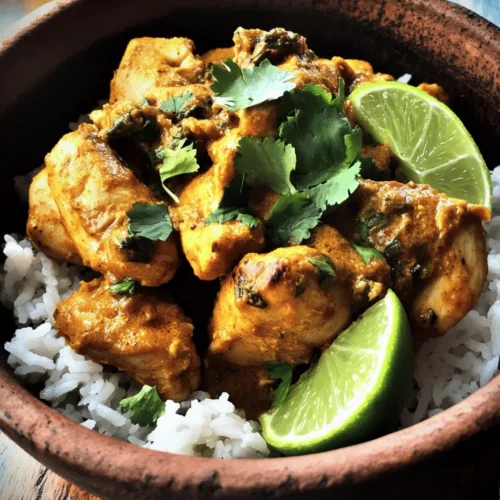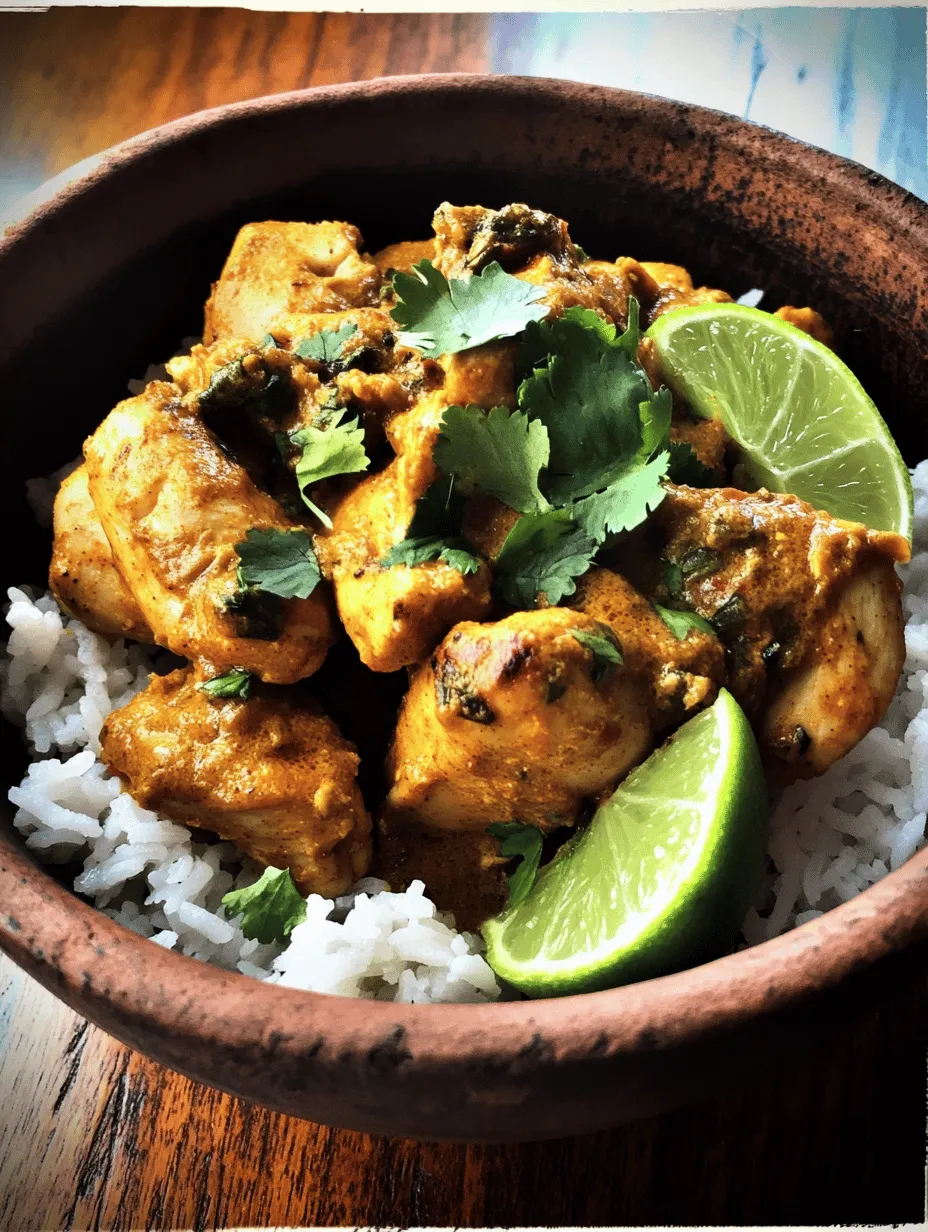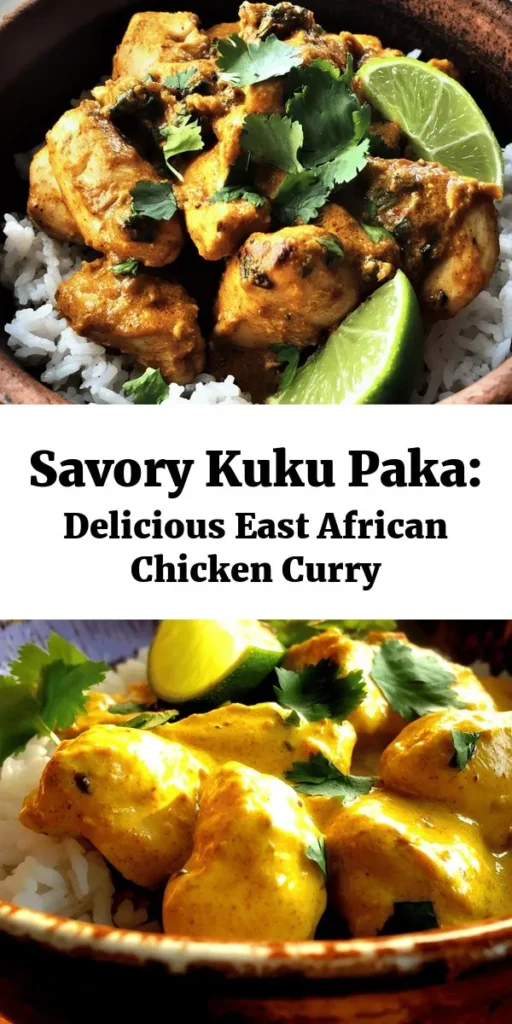Introduction
Kuku Paka is a delightful and aromatic chicken curry that is deeply rooted in the culinary traditions of East Africa, particularly among Swahili-speaking communities. This dish, which translates to “chicken in coconut,” showcases the unique blend of flavors that characterizes East African cuisine. With its tantalizing aroma and rich, creamy texture, Kuku Paka has gained popularity not just in homes across East Africa but around the world, offering a taste of the region’s vibrant culinary heritage.
What makes Kuku Paka so appealing is its harmonious blend of spices and fresh ingredients. The savory chicken is enveloped in a luscious coconut milk sauce, infused with aromatic spices and herbs that create a mouthwatering experience. The recipe is straightforward, making it an accessible choice for both seasoned cooks and kitchen novices alike. Its versatility allows it to be served on various occasions, whether it’s a casual family dinner or a festive celebration.
The Origin of Kuku Paka
The roots of Kuku Paka can be traced back to the rich tapestry of East African history, where diverse culinary influences have merged over centuries. The dish reflects the historical interactions between indigenous communities and traders from the Indian subcontinent, resulting in a unique fusion of flavors. Indian cooking techniques and spices have significantly influenced East African cuisine, leading to the creation of dishes like Kuku Paka, which embodies this cross-cultural culinary exchange.
Kuku Paka is not just a single recipe; it varies from region to region, each culture adding its own twist to the dish. For instance, in coastal regions of Kenya and Tanzania, you may find variations that include additional seafood or different spices, showcasing the local bounty and culinary creativity. Across East Africa, Kuku Paka is often enjoyed with rice, chapati, or ugali, making it a staple at family gatherings and social events, where food is an essential part of the celebration.
Ingredients Breakdown
To create a mouthwatering Kuku Paka, it’s essential to use high-quality, fresh ingredients that contribute to the dish’s complex flavor profile. Here’s a closer look at each ingredient involved in this flavorful chicken curry:
Whole Chicken
The foundation of any great Kuku Paka is the chicken itself. Opting for a whole chicken not only enhances the flavor but also allows for a more succulent and tender result. Fresh, high-quality chicken is crucial, as it absorbs the spices and marinades effectively. When selecting your chicken, look for one that is organic and free-range if possible, as this ensures a richer flavor and better texture in the final dish.
Coconut Milk
Coconut milk is a key ingredient in Kuku Paka, adding a creamy richness that balances the spices and enhances the overall taste. It provides a smooth texture and a subtle sweetness that complements the savory elements of the dish. When choosing coconut milk, look for brands that use natural ingredients without additives to ensure the best flavor. Full-fat coconut milk is recommended, as it yields a more luxurious sauce.
Aromatics
The aromatic trio of onion, garlic, and ginger forms the backbone of the flavor in Kuku Paka. Onions are sautéed until golden brown, providing a sweet and savory base for the curry. Garlic adds a pungent and slightly spicy kick, while ginger introduces a warm, zesty note that brightens the dish. Together, these aromatics work in harmony to create a fragrant foundation that enhances the chicken and coconut milk.
Spices
The spice blend is where Kuku Paka truly shines. Key spices include:
– Turmeric: Known for its vibrant yellow color and earthy flavor, turmeric also boasts anti-inflammatory properties.
– Cumin: This spice adds a warm, nutty flavor and aids in digestion.
– Coriander: Ground coriander seeds impart a citrusy flavor that enhances the overall taste of the dish.
– Paprika: Offering a mild sweetness and deep red color, paprika contributes both flavor and visual appeal.
– Garam Masala: A quintessential Indian spice blend, garam masala adds a complex aroma and depth of flavor, making it a staple in many East African dishes.
These spices not only elevate the taste but also provide various health benefits, making Kuku Paka a delicious and nutritious choice.
Fresh Herbs
To finish off the dish, fresh herbs like cilantro and lime juice are essential for brightening the flavors. Cilantro adds a fresh, herbaceous note that cuts through the richness of the coconut milk, while a splash of lime juice adds acidity and balances the dish beautifully. This combination of fresh herbs enhances the overall flavor profile, making each bite of Kuku Paka truly delightful.
Preparation Steps Explained
To make a flavorful Kuku Paka, following the preparation steps carefully is crucial for achieving the best results. Here’s a detailed breakdown of the steps involved in creating this delicious dish:
Marinating the Chicken
One of the most important steps in preparing Kuku Paka is marinating the chicken. Marination enhances the flavor and tenderness of the meat, allowing the spices to penetrate deeply. For optimal results, consider marinating the chicken for at least 30 minutes, although overnight marination is ideal for maximum flavor absorption. This process ensures that each bite is infused with the aromatic spices, creating a more flavorful dish.
To marinate the chicken, combine the spices, garlic, ginger, and a splash of coconut milk in a bowl. Coat the chicken thoroughly and let it sit in the refrigerator, allowing the flavors to meld while you prepare the other ingredients.
Sautéing the Aromatics
Once the chicken has marinated, it’s time to sauté the aromatics. Begin by heating oil in a large pot or skillet over medium heat. Add finely chopped onions and cook them until they turn golden brown. This step is crucial, as caramelizing the onions enhances their natural sweetness and adds depth to the curry.
While sautéing the onions, be mindful not to rush the process. Stir occasionally to ensure even cooking and prevent burning. After the onions are golden, add minced garlic and ginger to the pot. These ingredients should be cooked just long enough to become fragrant, typically around one to two minutes. Balancing the flavors with the right amount of garlic and ginger is key; too much can overpower the dish, while too little may result in a lack of depth.
Browning the Chicken
With the aromatics ready, it’s time to add the marinated chicken to the pot. Browning the chicken is an essential step that develops rich flavors and creates a beautiful color. Ensure that the pot isn’t overcrowded, as this can cause the chicken to steam rather than brown. Brown the chicken pieces on all sides for about 5-7 minutes, allowing a nice crust to form.
To achieve even browning, consider cooking the chicken in batches if necessary. Once the chicken is browned, remove it from the pot and set it aside. This step helps to lock in the juices and flavor, setting the stage for the final assembly of the dish.
As we continue to explore the preparation of Kuku Paka, the next steps will involve combining the browned chicken with the coconut milk and spices for a truly delectable finish. Stay tuned for the next part of this flavorful journey!

Combining Ingredients
The foundation of a flavorful Kuku Paka lies in the perfect blend of ingredients, particularly the coconut milk and chicken broth. When preparing this dish, aim for a rich and creamy texture that enhances the overall experience. Start by adding your coconut milk to the pot first. This will serve as the base for your curry, providing a luscious creaminess that complements the spices and chicken. Gradually introduce the chicken broth, stirring gently to combine.
The combination of coconut milk and chicken broth is crucial for achieving a well-rounded flavor profile. Coconut milk brings a subtle sweetness and richness, while the chicken broth adds depth and savory notes. For the best results, use full-fat coconut milk; its creamy consistency creates a luxurious sauce that clings to the chicken. As you mix these two liquids, pay attention to the consistency; you want a smooth, homogenous mixture that will envelop the chicken as it simmers.
Discussion on the Simmering Process
Simmering is an essential technique in cooking Kuku Paka, as it allows the flavors to meld beautifully while ensuring the chicken remains tender and juicy. After combining the coconut milk and chicken broth, bring the mixture to a gentle simmer over medium heat. This stage is where the magic happens; the heat will activate the spices, releasing their aromatic oils and enhancing the overall flavor of the dish.
As the chicken simmers in this fragrant mixture, it absorbs the flavors of the coconut milk and spices, becoming infused with a rich taste that sets Kuku Paka apart from other curries. The longer you let it simmer, the more pronounced the flavors will be. However, be cautious not to boil the mixture vigorously, as this can lead to tough chicken and a separated sauce. Aim for a slow simmer, allowing everything to meld together harmoniously.
Final Seasoning
Once the chicken is tender and cooked through, it’s time for the final touches. Adjusting the seasoning with salt and lime juice is vital for achieving a balanced flavor. Start by tasting the curry; this will guide you in determining how much salt is needed. A pinch of salt enhances the overall taste, bringing out the flavors of the spices and the natural sweetness of the coconut milk.
Next, add a squeeze of fresh lime juice. This brightens the dish and adds a refreshing acidity that cuts through the richness of the coconut milk. Stir well, taste again, and adjust as needed. The goal is to create a dish that has depth, complexity, and a delightful balance of flavors.
Cooking Techniques and Tips
Cooking on the Stove Versus Using a Slow Cooker or Pressure Cooker
While Kuku Paka is traditionally made on the stove, you can also prepare it using a slow cooker or pressure cooker for convenience. If you choose to cook it on the stove, follow the steps outlined above, carefully monitoring the simmering process to ensure the chicken cooks evenly.
Using a slow cooker allows for a hands-off approach; simply add all the ingredients and let it cook on low for 6-8 hours. This method is excellent for busy days, as the slow cooking process melds the flavors beautifully. Alternatively, a pressure cooker can significantly reduce cooking time. In this case, sauté the onions and spices first, then add the remaining ingredients and cook under high pressure for about 10-15 minutes.
The Role of Simmering in Developing Flavors and Tenderness in Chicken
Simmering plays a critical role in tenderizing the chicken and building flavor complexity. The gentle heat allows the spices to infuse into the chicken, ensuring each bite is flavorful. It’s essential to monitor the simmering process; too much heat can lead to overcooked chicken, while too little may result in a lack of depth in flavor. Aim for a low simmer, which encourages the chicken to absorb the coconut milk and spices without drying out.
Importance of Tasting and Adjusting Seasoning Throughout the Cooking Process
Throughout the cooking process, tasting and adjusting seasoning is crucial. As flavors develop, you may find that the dish needs a bit more salt, spice, or acidity. Don’t hesitate to tweak the seasoning at various stages. Your palate is the best guide for creating a delicious Kuku Paka that suits your personal taste.
Serving Suggestions
Traditional Accompaniments
Kuku Paka is typically served with rice or flatbreads, making it a delightful and satisfying meal. The creaminess of the curry pairs perfectly with fluffy basmati rice, which absorbs the rich sauce beautifully. For those who prefer a more traditional approach, serve it alongside chapati or naan, allowing diners to scoop up the curry and enjoy the flavors together.
Creative Serving Ideas
While traditional accompaniments are wonderful, feel free to get creative with your serving ideas. Kuku Paka can be used in wraps, providing a flavorful filling that’s perfect for a quick lunch or dinner. Simply spoon the curry into a tortilla or flatbread, add some fresh greens, and roll it up for a delightful meal on the go.
Another creative option is to use Kuku Paka as a topping for salads. The rich chicken curry adds protein and flavor to a bed of fresh greens, vegetables, and grains. Drizzle with a light vinaigrette to balance the dish and add a refreshing touch.
Presentation Tips
When serving Kuku Paka, presentation plays an essential role in enhancing the dining experience. Use a large, shallow bowl to showcase the curry, and garnish with freshly chopped cilantro or a sprinkle of toasted coconut for visual appeal. Serve with a side of rice or flatbreads arranged neatly, and consider adding lime wedges for an extra pop of color and flavor. A well-presented dish not only looks inviting but also enhances the overall dining experience.
Nutritional Information
Overview of Nutritional Benefits
Kuku Paka is not only delicious but also packed with nutritional benefits thanks to its wholesome ingredients. Chicken is an excellent source of protein, essential for muscle repair and overall health. Coconut milk adds healthy fats, particularly medium-chain triglycerides (MCTs), which can provide quick energy and support metabolism.
The spices used in Kuku Paka, such as turmeric and ginger, also boast numerous health benefits. Turmeric contains curcumin, known for its anti-inflammatory properties, while ginger can aid digestion and reduce nausea.
Commentary on Health Aspects of Coconut Milk and Spices
Coconut milk is a key ingredient in Kuku Paka that contributes to both flavor and health. While it is higher in calories than some other dairy alternatives, it is also rich in vitamins C, E, and B vitamins, along with minerals like magnesium and potassium. When consumed in moderation, coconut milk can be a nutritious addition to your diet.
The spices not only enhance taste but also provide health benefits. For instance, cumin can aid digestion, while coriander has antioxidant properties. Incorporating these spices into your diet through Kuku Paka contributes to overall well-being.
Caloric and Macronutrient Breakdown Per Serving
On average, a serving of Kuku Paka contains approximately 400-500 calories, depending on the portion size and specific ingredients used. The macronutrient breakdown typically includes:
– Protein: 30 grams
– Carbohydrates: 20 grams
– Fat: 25 grams
This breakdown can vary based on whether you serve the curry with rice or flatbreads. Regardless, Kuku Paka is a satisfying meal that provides a good balance of protein, healthy fats, and carbohydrates.
Cultural Significance and Modern Adaptations
Kuku Paka in Contemporary Cuisine
Kuku Paka is a cherished dish in East African cuisine, particularly among coastal communities. It represents a blend of influences from indigenous ingredients and culinary techniques, showcasing the rich culinary heritage of the region. In contemporary cuisine, chefs and home cooks are reinterpreting Kuku Paka, experimenting with flavors and presentation while maintaining its traditional essence.
Modern adaptations of Kuku Paka often include variations in spice blends or the addition of vegetables to enhance nutritional value. Chefs may also play with presentation, serving the dish in unique ways that highlight its vibrant colors and textures.
Variations: Vegetarian or Vegan Adaptations
For those seeking vegetarian or vegan adaptations of Kuku Paka, there are plenty of options. Instead of chicken, you can use chickpeas, tofu, or tempeh as protein sources. These ingredients absorb the flavors of the coconut milk and spices beautifully, making for a satisfying plant-based dish.
Moreover, incorporating a variety of vegetables, such as bell peppers, spinach, or sweet potatoes, can enhance the dish’s nutritional profile while adding color and texture. Adjust the cooking time accordingly to ensure that vegetables are cooked to perfection.
The Role of Kuku Paka in Family Gatherings and Celebrations
Kuku Paka is more than just a meal; it is a dish often served during family gatherings and celebrations. Its communal nature encourages sharing and brings people together, making it a perfect centerpiece for festive occasions. Whether it’s a holiday feast or a casual family dinner, Kuku Paka evokes feelings of warmth and togetherness, making it a cherished part of cultural traditions.
Conclusion
Kuku Paka embodies the essence of East African cuisine, combining rich flavors, tradition, and simplicity. This flavorful chicken curry, with its creamy coconut base and aromatic spices, is not only a delight to the palate but also a dish that honors cultural heritage. By sharing recipes like Kuku Paka, we foster understanding and appreciation across communities, celebrating the unique flavors and stories that food brings to our lives.
We encourage you to explore and enjoy the vibrant flavors of East African cuisine through Kuku Paka. Whether you prepare it for a special occasion or a weeknight dinner, this dish promises to satisfy and inspire. Embrace the culinary journey and savor the richness of Kuku Paka as it transports you to the coastal shores of East Africa.



